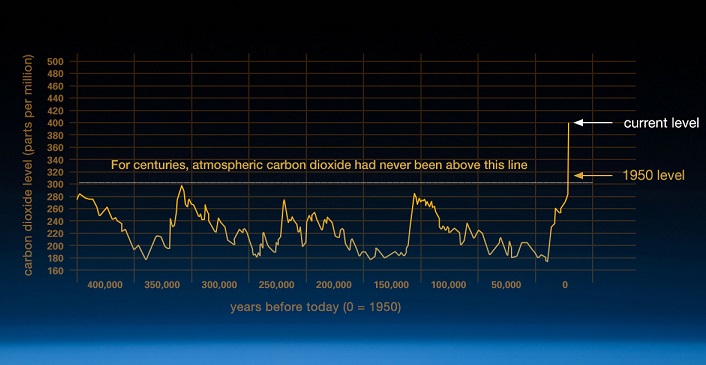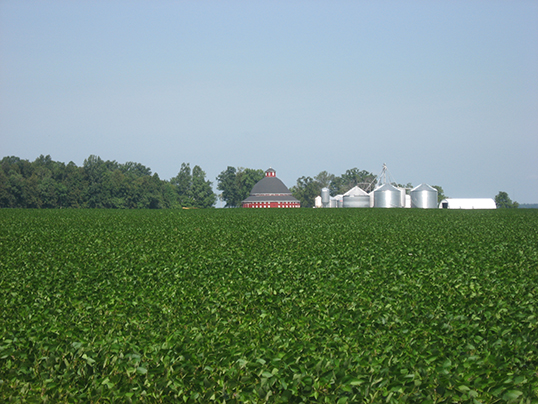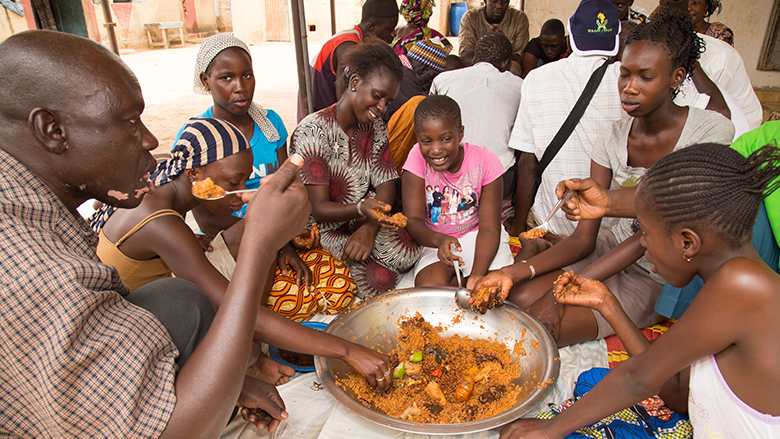Is Climate Change for Real?
Or..…Is the Sky Blue?
The Climates of our planet have undergone climate change and shifts and trends for millennia after millennia since the dawn of time. The difference now, is that we can actually measure it with more accuracy than ever before. When you combine that with the advances in atmospheric science, the consensus among scientists is that this time, we as humans play a significant role in its pace.
I’m not much of a political type. However, I remember actually laughing at the television when I heard Donald Trump say, “‘nobody really knows if climate change is real”.. quoting an article found from the Washington Post, “Trump Says Nobody Really Knows if Climate Change is for Real”. Yes, Mr. Trump, it’s for real.

This graph, based on the comparison of atmospheric samples contained in ice cores and more recent direct measurements, provides evidence that atmospheric CO2 has increased since the Industrial Revolution, thus leading to climate change. (Credit: https://climate.nasa.gov/evidence/ )
There are two aspects of Climate change for us all to ponder, and actively start doing something about.
Mitigation
Can we actually reduce the rate of climate change? The answer is yes, but the world must act as a community with that common goal. Reduction of greenhouse gases from burning fossil fuels, though easier said than done, can be a significant contributor. Enhancing the way CO2 Methane, and other greenhouse gases are stored in the ‘sinks’ that exist on the earth’s surface is the second step in this process. These sinks include water, soil, and forests. The key is patience, for even if we could implement these two steps, a significant amount of time is needed for our ecosystems to adapt. The consensus is, however, that it must take place.
Adaptation to Climate Change
The other important step is adaptation. Scientists, sociologists, community planners, and others are actively seeking ways in which we, as the most advanced species on the planet, can develop systems, convince governments, and transfer technology to populations which will allow us to meet the demands of rapidly increasing populations in developing countries while more extreme weather events become more frequent. Sea level encroachment is perhaps an even more daunting realization as so much human development occurs along the shores of the oceans.
For some regions of the world, Climate Change has its benefits. Longer growing seasons will potentially increase yields per hectare, expand the crops and varieties that can be grown, and change the makeup of farms in some regions.
Food Security
The Agricultural industry is stepping up to this challenge with new crop varieties that can not only survive, but thrive with significant yield increases in climatic regions never thought possible.
Climate Friendly Soybeans As the world’s population grows and the climate changes, food production will have to increase 70 percent within 35-40 years to meet global food needs, according to a recent U.N. estimate.
Building a Better Soybean for a Hot Dry Hungry World , By Carol Rasmussen, NASA Earth Science News Team

Scientists from NASA have combined efforts with plant breeders to develop a soybean variety which is leafier, trapping more of the sun’s rays in the plant than it needs for photosynthesis; produces more beans; and uses less water in the process. Photo Credit: NASA
Advancements in Other Crops
The World Bank-Funded, West Africa Agricultural Productivity Program (WAAPP), is actively hard at work, dedicated to resolving the hunger and agricultural productivity challenges across West Africa. Already feeling the ‘hit’ from Climate Change with extreme weather events and inadequate, erratic rainy seasons, this climatic region could continue seeing yields drop by as much as 25% according to some experts if they continue using techniques and crop technology of old. Enter WAAPP, and in cooperation with benefactors and funding from the World Bank; a total of 160 ‘climate-smart’ crop varieties have been introduced and integrated with a massive educational effort for the farmers managing them.

A family in Senegal gathered around a pot of cowpea stew made from one of the new varieties of high-yielding, drought-resistant cowpea.
Dasan Bobo/World Bank
“We used to produce 1 to 1.5 tons [of the older cowpea variety] but with a shorter rainy season that often comes late, we would harvest only about 800 kilograms,” Fatou Yalindiaye’s recalls. “With the older varieties that we were using, we didn’t even bother adding fertilizer because the rains didn’t last long enough for anything to grow. There wasn’t even enough to feed the livestock.” Here, Yalindiaye’s family gathers around a pot of stew, made from one of the new varieties of high-yielding, drought-resistant cowpea.
Yes, Climate Change is very real, Mr. Trump. Unlike any time in our history, however, nations are coming together as a planet and are learning how to “think Globally, and act locally”… bringing the brightest minds and giving them the necessary tools and machines to ensure a sustainable future for us all.
By: John Deibel, Agronomist and Contributing Writer to TractorExport
How do you liked this post? Let us know in Facebook or Google+
Sources for this article include:
1.) Climate Change and the Rise and Fall of Civilizations – – Dr. Jason Ur, Harvard University
2.) The weather and climate of the Tropics – metlink.org
4.) Building a Better Soybean for a Hot Dry Hungry World – By Carol Rasmussen, NASA Earth Science News Team
5.) Climate change: How do we know? NASA- Global Climate Change/Vital Signs of the Planet – Facts
6.) “Trump Says Nobody Really Knows if Climate Change is for Real”– Washington Post


